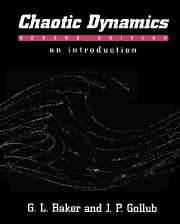Book contents
- Frontmatter
- Contents
- Preface
- Acknowledgments
- CHAPTER ONE Introduction
- CHAPTER TWO Some helpful tools
- CHAPTER THREE Visualization of the pendulum's dynamics
- CHAPTER FOUR Toward an understanding of chaos
- CHAPTER FIVE The characterization of chaotic attractors
- CHAPTER SIX Experimental characterization, prediction, and modification of chaotic states
- CHAPTER SEVEN Chaos broadly applied
- Further reading
- Appendix A Numerical integration – Runge–Kutta method
- Appendix B Computer program listings
- Appendix C Solutions to selected problems
- References
- Index
- Diskette order information
CHAPTER ONE - Introduction
Published online by Cambridge University Press: 05 June 2012
- Frontmatter
- Contents
- Preface
- Acknowledgments
- CHAPTER ONE Introduction
- CHAPTER TWO Some helpful tools
- CHAPTER THREE Visualization of the pendulum's dynamics
- CHAPTER FOUR Toward an understanding of chaos
- CHAPTER FIVE The characterization of chaotic attractors
- CHAPTER SIX Experimental characterization, prediction, and modification of chaotic states
- CHAPTER SEVEN Chaos broadly applied
- Further reading
- Appendix A Numerical integration – Runge–Kutta method
- Appendix B Computer program listings
- Appendix C Solutions to selected problems
- References
- Index
- Diskette order information
Summary
The irregular and unpredictable time evolution of many nonlinear systems has been dubbed ‘chaos.’ It occurs in mechanical oscillators such as pendula or vibrating objects, in rotating or heated fluids, in laser cavities, and in some chemical reactions. Its central characteristic is that the system does not repeat its past behavior (even approximately). Periodic and chaotic behavior are contrasted in Figure 1.1. Yet, despite their lack of regularity, chaotic dynamical systems follow deterministic equations such as those derived from Newton's second law.
The unique character of chaotic dynamics may be seen most clearly by imagining the system to be started twice, but from slightly different initial conditions. We can think of this small initial difference as resulting from measurement error, for example. For nonchaotic systems this uncertainty leads only to an error in prediction that grows linearly with time. For chaotic systems, on the other hand, the error grows exponentially in time, so that the state of the system is essentially unknown after a very short time. This phenomenon, which occurs only when the governing equations are nonlinear, is known as sensitivity to initial conditions. Henri Poincare (1854–1912), a prominent mathematician and theoretical astronomer who studied dynamical systems, was the first to recognize this phenomenon. He described it as follows: ‘…it may happen that small differences in the initial conditions produce very great ones in the final phenomena. A small error in the former will produce an enormous error in the latter.
- Type
- Chapter
- Information
- Chaotic DynamicsAn Introduction, pp. 1 - 6Publisher: Cambridge University PressPrint publication year: 1996
- 5
- Cited by



